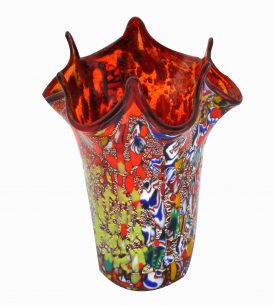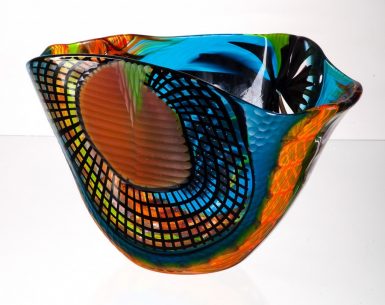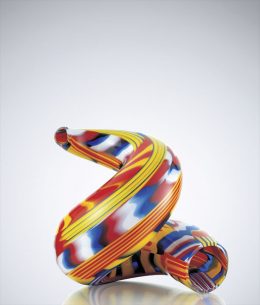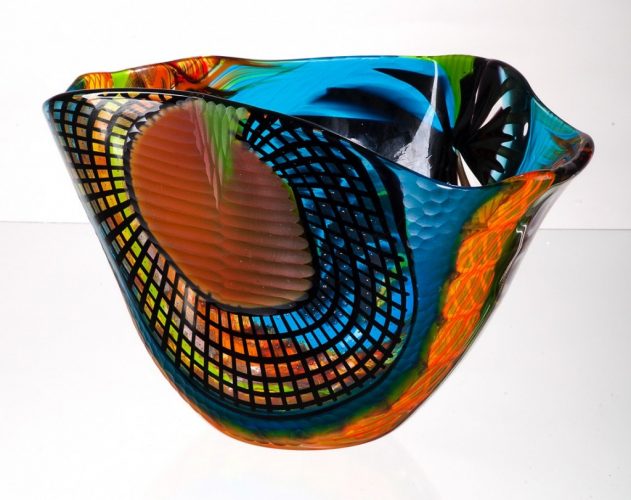 The term “Murano glass”, widely used to describe the colourful, intricate pieces that flow out of Italy into the eager hands of collectors even today, does not refer to a specific glass manufacturer; instead, this label is born of location. The Murano islands, a small cluster of land masses that dot the turquoise waters of the Adriatic Sea just north of Venice, have been bound up with the art of glass blowing since time immemorial.
The term “Murano glass”, widely used to describe the colourful, intricate pieces that flow out of Italy into the eager hands of collectors even today, does not refer to a specific glass manufacturer; instead, this label is born of location. The Murano islands, a small cluster of land masses that dot the turquoise waters of the Adriatic Sea just north of Venice, have been bound up with the art of glass blowing since time immemorial.
Ancient Origins
The picturesque Lagoon of Venice has been the site of glassmaking since the 8th century, preserving a hint of the glory of the Classical era while much of the rest of Europe still languished in the dark ages. As the centuries rolled on, the artisans in the region built on their existing store of knowledge, adding techniques they absorbed through the Republic of Venice’s frequent trade with the Eastern Mediterranean and the Islamic territories of the Levant and North Africa, where glassmaking had continued to flourish unabated by the fall of the Roman Empire.
For the glassmakers of Venice, the conquest of Constantinople in 1204 was oddly fortuitous, as it distilled the practices of the glass producers of the imperial city outward into the surrounding populations. By 1291, the same year all glass production in the area was moved to Murano (as the government of Venice had voted to ban glass furnaces on the more populous central islands), the glassmakers of the Venetian lagoon had reworked much of what they had learned into new proprietary production skills.
Indeed, it was this development that many historians now believe propelled the decision to isolate glass production on the Murano islands, rather than the fear of setting fire to nearby buildings (which had once been posited as the root of the choice). Noticing their local artisans were mastering the art of glass blowing in novel ways, the Venetian authorities sought to protect this emerging knowledge from the prying eyes of foreigners. This theory is backed up by records of the Murano glass-blowing artisans being treated nearly akin to prisoners, insulated from all contact with anyone who might spread their secrets abroad.
While glassmaking as a whole was still largely utilitarian in nature during this time, the master craftsmen of Murano began to branch out into creating beautiful, intricate objects whose sole purpose was to act as decoration. Though practical objects like mirrors brought in much of the revenue the Republic of Venice received from its glassmaking ventures, these new decorative experiments allowed Murano glass-blowing craftspeople to experiment with bold, complex new techniques that advanced the art of Murano glass-blowing as a whole and helped to propel Venice to the top of Europe’s glass-producing centres.
A Difficult Middle Age
 As so often happens with monopolies, eventually the glassmakers of Murano could both no longer protect all of their knowledge and grew complacent in their centuries of success. As such, rival regions throughout Europe—particularly France and Moravia—began to steal the Venetians’ thunder by the 1600s. This could not have come at a worse time, given that the trade routes that had once so faithfully supplied Venice with the raw materials needed for glass production were also shifting, and the region’s ancient trading advantage was being lost in the process.
As so often happens with monopolies, eventually the glassmakers of Murano could both no longer protect all of their knowledge and grew complacent in their centuries of success. As such, rival regions throughout Europe—particularly France and Moravia—began to steal the Venetians’ thunder by the 1600s. This could not have come at a worse time, given that the trade routes that had once so faithfully supplied Venice with the raw materials needed for glass production were also shifting, and the region’s ancient trading advantage was being lost in the process.
As Venice declined, dwindling away from being the political and commercial powerhouse it had once been, so too did Murano lapse into mediocrity. By the time of the conquest of Venice by Napoleon’s French forces in 1797 (and the subsequent transfer, in 1814, of Venice from France to the Austrian Habsburg Empire), the industry was a mere shadow of its former self. It is therefore little wonder that the new Austrian rulers chose to favour Bohemia as the glassmaking centre of their empire and soon brought in regulation to ensure that their wishes were carried out.
In order to stifle the glass blowers of Murano, the Austrian government heavily taxed and restricted the import of glassmaking materials into Venice, causing the number of active glass furnaces in Murano to plummet from 24 in 1800 to a mere 13 by 1820 (and of those 13, only 5 carried on the ancient art of glass blowing; the rest were relegated to making beads and similarly inconsequential knick-knacks).
An Unexpected Revival
What the Austrian authorities no doubt expected to be the death knell of glassmaking on Murano turned out to have a curiously opposite effect on the remainder of the region’s glass artisans; angered by the harsh restrictions, the islands’ traditional glassblowing families were roused from their prior complacency and spurred into action. Old techniques were revived, despite their prohibitive cost and the relatively low demand that existed for such decorative wares.
This tenacity would come to pay off; by the 1850s, the tides were once again turning in the region’s favour. In 1854, a new glass furnace was founded on Murano by six enterprising sons of Pietro Toso (who dubbed their fledgling firm Fratelli Toso), and while its first products were utilitarian, the brothers soon began to demonstrate skills and ambition that went far beyond the mundane.
Then, in 1859, a lawyer from Vicenza named Antonio Salviati arrived in Murano, bringing with him a dream—his firm, Salviati Dott, would tap into the hitherto unexplored market for glass tiles (needed for repairing and creating the numerous mosaics found around Venice). The savvy businessman chose to employ master glassblowers like Lorenzo Radi, who had already made a name for himself by resurrecting many of the lost glassmaking techniques from Murano’s prior zenith in the 1400s. In but little time, the firm was attracting international acclaim, most notably through its prize-winning display of chalcedony glass at the 1862 world exhibition in London—a success Salviati soon built open by opening a London sales office.
In the hands of capable marketers like Salviati, Murano wares were once again able to reach the world beyond the confines of the Habsburg Empire, which would itself soon begin to wane in power. In the decades to come, as Venice became fully Italian once again, Salviati and Fratelli Toso would find themselves joined by innovative firms like Fratelli Barovier and Francesco Ferro & Figlio, and the region flourished anew.
A Modern Phenomenon
 Keen to avoid replicating the mistakes of the middle ages, the Murano glass-blowing experts were sure to experiment with the many design trends of the late 1800s, quickly mastering the Art Nouveau style which was then captivating the world with its fluid, natural lines and rejection of stuffy, cluttered Victorianism. Then, when the first Venice Biennale was staged in 1895, the glassmakers of Murano were exposed to the avant-garde and innovative art that was being developed all over Europe, resulting in a fresh wave of inspiration. Artists like Vittorio Zecchin, Napoleone Martinuzzi, Hans Stoltenberg-Lerche, and Teodoro Wolf-Ferrari would likewise step in to contribute their creative vision and design expertise to the now-booming glass firms of Murano.
Keen to avoid replicating the mistakes of the middle ages, the Murano glass-blowing experts were sure to experiment with the many design trends of the late 1800s, quickly mastering the Art Nouveau style which was then captivating the world with its fluid, natural lines and rejection of stuffy, cluttered Victorianism. Then, when the first Venice Biennale was staged in 1895, the glassmakers of Murano were exposed to the avant-garde and innovative art that was being developed all over Europe, resulting in a fresh wave of inspiration. Artists like Vittorio Zecchin, Napoleone Martinuzzi, Hans Stoltenberg-Lerche, and Teodoro Wolf-Ferrari would likewise step in to contribute their creative vision and design expertise to the now-booming glass firms of Murano.
By 1921, Murano’s legendary reputation was solidified, bolstered by the arrival of Milan natives Giacomo Cappellin and Paolo Venini, who founded their glassworks, Vetri Soffiati Muranesi Cappellin, Venini & C., with a vision to embrace the bleeding edge of modern design. Thanks to their efforts, in unison with the diligence and expertise of Murano’s ancient glassmaking families, the transition into Art Deco was made seamlessly, the challenges of World War 2 weathered, and the emergence of post-war creativity in the 1950s assured.
Indeed, so thorough was this modern revival that today, Murano glass from the mid-century period (the 1950s-1960s) is frequently the most sought-after by collectors, known for its glowing vibrancy of colour and daring design. Likewise, many of Murano’s historic glassworks are still going strong, despite an overall decline in the worldwide demand for decorative luxuries and the intrusion of cheaper knockoff wares from Asia.
Still, this legacy, though proud, is undoubtedly under threat; in order to help preserve the might of Murano, it’s imperative that collectors learn to identify the real article when purchasing Italian art glass, as described in our prior article here.

